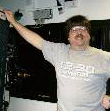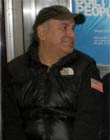|
|
This topic comprises 2 pages: 1 2
|
|
Author
|
Topic: How would San Francisco cope?
|
|
|
Darryl Spicer
Film God

Posts: 3250
From: Lexington, KY, USA
Registered: Dec 2000
|
 posted 09-06-2005 09:23 AM
posted 09-06-2005 09:23 AM



I hate to say it but people in San Fransisco will be better prepared than the people in the areas listed below.
The New Madrid Seismic zone lies within the central Mississippi Valley, extending from northeast Arkansas, through southeast Missouri, western Tennessee, western Kentucky to southern Illinois. Historically, this area has been the site of some of the largest earthquakes in North America. Between 1811 and 1812, 4 catastrophic earthquakes, with magnitude estimates greater than 7.0, occurred during a 3-month period. Hundreds of aftershocks followed over a period of several years. The largest earthquakes to have occurred since then were on January 4, 1843 and October 31, 1895 with magnitude estimates of 6.0 and 6.2 respectively. In addition to these events, seven events of magnitude >= 5.0 have occurred in the area. Instruments were installed in and around this area in 1974 to closely monitor seismic activity. Since then, more than 4000 earthquakes have been located, most of which are too small to be felt. On average one earthquake per year will be large enough to be felt in the area.
The New Madrid seismic zone is so named because the town of New Madrid, Missouri was the closest settlement to the epicenters of the 1811-1812 quakes. At that time, St. Louis and other major cities in the central U.S. were sparsely settled. At least 3 of the series of earthquakes were felt throughout much of the U.S. and as far away as Quebec. The potential for the recurrence of such earthquakes and their impact today on densely populated cities in and around the seismic zone, has generated much research devoted to understanding earthquakes. By closely monitoring the earthquake activity, scientists can hope to understand their causes, recurrence rates, ground motion and disaster mitigation. The probability for an earthquake of magnitude 6.0 or greater is significant in the near future, with a 50% chance by the year 2000 and a 90% chance by the year 2040. A quake with a magnitude equal to that of the 1811- 1812 quakes could result in great loss of life and property damage in the billions of dollars. Scientists believe we could be overdue for a large earthquake and through research and public awareness may be able to prevent such losses.
New Madrid Seismic Zone
| IP: Logged
|
|
|
|
|
|
|
|
|
|
|
|
|
|
Ron Yost
Master Film Handler
Posts: 344
From: Paso Robles, CA
Registered: Aug 2003
|
 posted 09-08-2005 08:08 PM
posted 09-08-2005 08:08 PM




Here's a reeeealy long article that appeared today in The Los Angeles Times regarding our (California's) state of preparedness for major disaster:
--------------------------
California Earthquake Could Be the Next Katrina By Jia-Rui Chong and Hector Becerra Times Staff Writers
Thu Sep 8, 7:55 AM ET
Copyright 2005 The Los Angeles Times
U.S. Geological Survey seismologist Lucy Jones remembers attending an emergency training session in August 2001 with the Federal Emergency Management Agency that discussed the three most likely catastrophes to strike the United States.
First on the list was a terrorist attack in New York. Second was a super-strength hurricane hitting New Orleans. Third was a major earthquake on the San Andreas fault.
Now that the first two have come to pass, she and other earthquake experts are using the devastating aftermath of Hurricane Katrina as an opportunity to reassess how California would handle a major temblor.
Jones, scientist-in-charge for the geological survey's Southern California Earthquake Hazards Team, and other experts generally agree that California has come a long way in the last two decades in seismic safety.
In Los Angeles, all but one of 8,700 unreinforced masonry buildings considered the most likely to collapse in a major quake have been retrofitted or demolished. The state spent billions after the 1994 Northridge quake to retrofit more than 2,100 freeway overpasses, reporting this week that only a handful remain unreinforced.
Despite these improvements, however, officials believe that a major temblor could cause the level of destruction and disruption seen over the last week on the Gulf Coast.
More than 900 hospital buildings that state officials have identified as needing either retrofitting or total replacement have yet to receive them, and the state recently agreed to five-year extensions to hospitals that can't meet the 2008 deadline to make the fixes. More than 7,000 school buildings across the state would also be vulnerable during a huge temblor, a state study found, though there is no firm timetable for upgrading the structures.
And four Los Angeles Police Department facilities including the Parker Center headquarters in downtown worry officials, because they were built to primitive earthquake standards and might not survive a major temblor. Only two of the LAPD's 19 stations meet the most rigorous quake-safe rules.
"We could be dealing with infrastructure issues a lot like New Orleans," Jones said. "Our natural gas passes through the Cajon Pass
. Water three pipelines cross the San Andreas fault in an area that is expected to go in an earthquake." Railway lines are also vulnerable, she said.
A catastrophic temblor at the right spot along the San Andreas could significantly reduce energy and water supplies at least temporarily, she and others said. Researchers at the Southern California Earthquake Center said there is an 80% to 90% chance that a temblor of 7.0 or greater magnitude will strike Southern California before 2024.
"We aren't anywhere close to where I wish we were" in terms of seismic safety, Jones said.
Seismologists are particularly concerned about a type of vulnerable building that has received far less attention than unreinforced masonry.
There are about 40,000 structures in California made from "non-ductile reinforced concrete", a rigid substance susceptible to cracking. This was a common construction ingredient for office buildings in the 1950s and '60s, before the state instituted stricter standards. Few such structures have been seismically retrofitted, officials said.
Seismic safety advocates have also recently lost some major battles in Sacramento. The state rejected a proposal from the Seismic Safety Commission in the wake of the 2003 San Simeon earthquake to force owners of unreinforced masonry buildings to post warning signs. In that quake, two women died when the roof slid off of a two-story Paso Robles brick building where they worked.
Last week, the Legislature sent to the governor's desk a bill that encourages local governments to develop retrofitting programs for "soft story" wood-frame apartment buildings.
There are an estimated 70,000 such structures in the state, and experts worry that they could sustain major quake damage, because they often have tuck-under parking and lack solid walls at their bases.
The danger of this kind of construction was illustrated in the 1994 collapse of the Northridge Meadows apartment complex, in which 16 residents were killed.
There are other potential safety gaps as well.
Although Los Angeles, Long Beach, Pasadena and several other cities have reinforced almost all their masonry buildings, about a third of such structures across the state remain unprotected, said Frank Turner, an engineer with the Seismic Safety Commission.
A state study published last year on hazard reduction paints a sobering picture of California's earthquake danger. About 62% of the population lives in a zone of high earthquake danger, including 100% of the population of Ventura County, 99% of Los Angeles County and 92% of Riverside County.
Since 1971, there have been at least 13 earthquakes of magnitude 6.0 or greater in the state, and research conducted after the 1989 Loma Prieta quake in the Bay Area found a 62% probability that at least one earthquake of magnitude 6.7 or more would strike the Bay Area before 2032.
"We're pretty confident we have some of the best buildings in the world here, but
there are always going to be losses, because these are extraordinary events," Turner said.
Still, Southern California's geography could help prevent a catastrophe on the scale of that in New Orleans.
Because the Los Angeles region is so much larger than the Louisiana city, it is difficult to conceive of a disaster "short of an A-bomb" that would blanket the whole city, let alone the whole county, in ruin, said Lee Sapaden, a spokesman for Los Angeles County's Office of Emergency Management.
Earthquakes tend to do the most damage closest to the epicenters. The 1994 Northridge quake, for example, damaged a large swath of the San Fernando Valley as well as parts of Hollywood and the Westside. But areas farther to the east and south, such as Long Beach and Orange County, saw little damage.
A large quake in the Valley would probably still allow emergency supplies and rescuers to reach the area from other locations such as the San Gabriel Valley and South Bay, Sapaden said.
Emergency crews would have better mobility than those in New Orleans, he added, because even if freeways were wrecked, aid would probably be able to get through the vast majority of areas on surface streets. "Here in Southern California, Riverside, San Bernardino, Orange and Santa Barbara counties would help us out, just like we would help them," he said.
One of the biggest concerns of seismic safety officials is the fate of hospitals.
The 1971 Sylmar earthquake pushed Olive View Medical Center a foot off its foundation, causing the first floor to collapse, killing three patients and a hospital worker. The 1994 Northridge quake knocked 23 hospitals temporarily out of service.
After that quake, the Legislature passed a law requiring that hospitals retrofit buildings to withstand a major temblor or replace them with new ones. About 78% of hospitals have at least one building deemed at risk, said Jan Emerson, spokeswoman for the California Hospital Assn.
But hospitals, many of which are fighting budget problems, have balked at the price tag estimated at $24 billion for 2002-2030 and in many cases have successfully pushed Sacramento to delay the retrofitting deadline. The state has already granted about 200 requests for extensions to make the necessary repairs by 2013, according to a state document.
Safety officials said more work is also needed at schools.
A 2002 state study found that more than 7,500 school buildings across California are expected to "perform poorly" in a major temblor.
The Los Angeles Unified School District has completed seismic upgrades to nearly 2,000 buildings, spending $222 million on the effort, according to Richard Luke, director of design for the district.
But the district has not finished upgrades on 600 portable buildings and will look at an additional 239 buildings identified by the Division of State Architect as possibly performing poorly during a major quake.
Jones of the geological survey and Turner of the Seismic Safety Commission believe that one worst-case scenario would involve a massive temblor on the San Andreas fault around where major utility lines run, possibly compromising water and power supplies.
"We should not be at all surprised if something similar to Hurricane Katrina mirrors itself in California," Turner said. "There have been lots of articles written about the failure of levees in the [Sacramento-San Joaquin] Delta, the loss of drinking water in California. This is just the tip of the iceberg."
About 60% of Southern California's water is imported from outside the region in three major aqueducts that cross the San Andreas fault, making them particularly vulnerable to major earthquake damage.
One branch of the 444-mile California Aqueduct, which carries water from the delta, virtually sits on top of the fault for a few miles near Palmdale. A second aqueduct from the Colorado River crosses the fault near Beaumont. And the Los Angeles Aqueduct, which transports snowmelt from the eastern Sierra, runs across the San Andreas in a mountain tunnel between Lancaster and Santa Clarita.
Southern California water managers say they've made progress in recent years building local reserves they could turn to if they lost water from one or more of the transport systems.
With such efforts, "we feel even more confident we are able to provide sufficient water to sustain us during an earthquake," said Debra Man, chief operating officer of the Metropolitan Water District of Southern California, the region's main water wholesaler.
Jim McDaniels, chief operating officer for the Los Angeles Department of Water and Power's water system, said that if disaster struck, the DWP could double its groundwater pumping within the basin and draw from its four big local reservoirs.
Major gas lines also come into Southern California over the San Andreas at several points, including at Indio, Palmdale, the Cajon Pass and the Tejon Ranch. Still, officials at the Southern California Gas Co. expressed confidence that the system could withstand a strong earthquake, noting they have been upgrading the pipeline for years.
Another open question is whether the major quake would cause damage to fire stations, police headquarters and facilities of other emergency agencies, possibly slowing their response. A state study found that many of the 1,300 emergency operations buildings were constructed before strict quake building standards were enacted in 1986, and that only a portion of those had been retrofitted.
At the LAPD, the only four facilities to meet the most recent and rigorous "essential building" standards are the department's newest: the West Valley and Mission police stations and two 911 dispatch centers.
Yvette Sanchez-Owens, head of the department's facilities management office, said she is most concerned about three stations built in the 1960s: Rampart, Hollenbeck and Harbor. Police officers at the Harbor station in San Pedro have been relocated to trailers while a new station is built; officers could be moved out of the Hollenbeck station in Boyle Heights sometime this fall as preparation for construction of a new station begins.
As for Parker Center, it already sustained significant damage during the Northridge earthquake. It is also scheduled to be replaced, but not for several years.
"It could be in real trouble," Sanchez-Owens said. "It's definitely not built up to standard."
------------------
Ron Yost
| IP: Logged
|
|
|
|
|
|
|
|
|
|
|
|
|
|
|
|
All times are Central (GMT -6:00)
|
This topic comprises 2 pages: 1 2
|
Powered by Infopop Corporation
UBB.classicTM
6.3.1.2
The Film-Tech Forums are designed for various members related to the cinema industry to express their opinions, viewpoints and testimonials on various products, services and events based upon speculation, personal knowledge and factual information through use, therefore all views represented here allow no liability upon the publishers of this web site and the owners of said views assume no liability for any ill will resulting from these postings. The posts made here are for educational as well as entertainment purposes and as such anyone viewing this portion of the website must accept these views as statements of the author of that opinion
and agrees to release the authors from any and all liability.
|

 Home
Home
 Products
Products
 Store
Store
 Forum
Forum
 Warehouse
Warehouse
 Contact Us
Contact Us




 Printer-friendly view of this topic
Printer-friendly view of this topic









![[Roll Eyes]](rolleyes.gif)


![[Razz]](tongue.gif)







